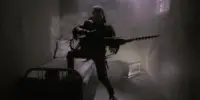When I heard that Christopher Smith was directing a haunted-house film that appeared to be in the vein of The Conjuring, my ears immediately perked up. Several of Smith’s previous works are absolute gems that I don’t hear nearly enough about from my friends, from the workplace slasher-comedy Severance to the mind- and time-bending horror-thriller Triangle. Smith has demonstrated his craft with historical fiction before with his 1300s-set plague action-horror Black Death (which, yes, stars legendary-for-dying-a-lot Sean Bean). Upon starting Smith’s latest directorial effort The Banishing, I was met with many familiar elements to past haunted house period pieces, but judging by the director’s track record of flipping predictable ideas on their heads, I knew there would be far more depth if I just waited—and, thankfully, this film more than paid off.
Set in the troubled times only just preceding World War II, The Banishing follows a family of three as they move into a new house to accommodate vicar Linus’s (John Heffernan) new parish. However, the house has a dark past, and soon enough, Linus’s wife Marianne (Jessica Brown Findlay) and her daughter Adelaide (Anya McKenna-Bruce) are seeing and hearing things at night. While you may think being surrounded by religious men like Linus and Father Malachi (John Lynch) would help them cast out the dark spirits, it’s awkward occultist Harry (Sean Harris, who I recognize from Mission: Impossible of all things) who Marianne may be forced to trust in order to protect her daughter and husband from suffering the same fate as the previous residents.
As I said, this is a story you’ve already heard before several times, but a fresh approach to classic tropes is always welcome. Here, Smith and writers David Beton, Ray Bogdanovich, and Dean Lines explore something a bit deeper than a priests-and-innocent-woman-vs.-ghosts narrative. There are no cries of “The power of Christ compels you!” and no easy answers as to whether the belief of the priests helps or harms their efforts to purify the house. As it turns out (and without spoiling any specifics), the building’s tragic backstory involves Christianity taken to unfortunate and violent extremes and even deals a bit with how religion demonizes the sexuality of women. The ghosts of the past want something, and praying them away won’t placate them one bit.

As the story progresses from mundane occurrences to time distortions and violent shocks to the system, the cast holds everything together with as much skill as they can muster—particularly with Findlay’s portrayal of a mother and wife with secrets of her own who’s willing to do whatever it takes to make sense of things and keep her family safe. The way she and John Heffernan’s vicar character interact feels all too much like real family turmoil as they butt heads over their daughter, their faith, and whether Harry the occultist is trustworthy or a lying, swindling charlatan. It doesn’t help that Sean Harris’s Harry is not very good with people, as seen in an early scene where he bursts into Linus’s church during off hours to try to warn him of the truth behind his new home, even as Linus tries to forcibly remove him from the grounds. There’s tension both natural and supernatural here, and it’s handled extremely well.
The supernatural tension in The Banishing is only furthered by the atmospheric direction and the unique scare sequences. With hardly a jump scare to be found, there are mirrors whose reflections don’t move when the people looking into them do, hallucinations of horrible deaths, and more than once, Marianne seeing herself somewhere she isn’t—and then suddenly being there. A particularly well-done example of this is a moment where she looks for her daughter, turns around, and sees multiple copies of herself floating in the air pressed against the wall a la American Horror Story: Coven. The next moment, she is one of these copies, trapped in midair with her face to the wall until she falls to the ground. The most haunting moments of this story manage to pull you in instead of making you want to look away.

I would be a terrible reviewer if I didn’t mention the last element that comes to mind when I think about seeing this film: The Banishing actually FEELS like a story straight out of the 1930s. Production designer Chris Richmond, set decorator Dominic Smithers, and costume designer Lance Milligan were excellent choices for this film; the house where most of the story takes place feels lavish, ancient, and flung out of time even for pre-war Essex, lending it an unsettling nature even when there’s nothing particularly horrifying happening outright. I could even see it becoming an iconic horror location in the near future.
Scenes in town, a bar, and a church feel similarly of their time. Marianne wears luxurious florals, smart day dresses, and the requisite spooky flowing nightgown, all of which are masterclasses in reflecting time, place, and character through the clothes one wears in a story; on the opposite end, Harry looks and dresses just as out of place as he seems through most of the film. Even Toydrum, score composers previously best known for their work as part of electronic music legends UNKLE, manage to apply their craft to the proper time period and create waves of atmosphere for the ghosts of the old house to float through. This is yet another movie where every gear fits together in its right place.
If you like ghosts, period horror, tense drama, or any of Christopher Smith’s previous work, you’ll be missing out if you don’t sit down to watch The Banishing as soon as it hits Shudder this Thursday, April 15th. It’s gripping, haunting, full of unique takes on suspense and spirits, and it feels both of and ahead of the time it’s set in in all the best ways. Put on an old record and enjoy the frights that await you.



